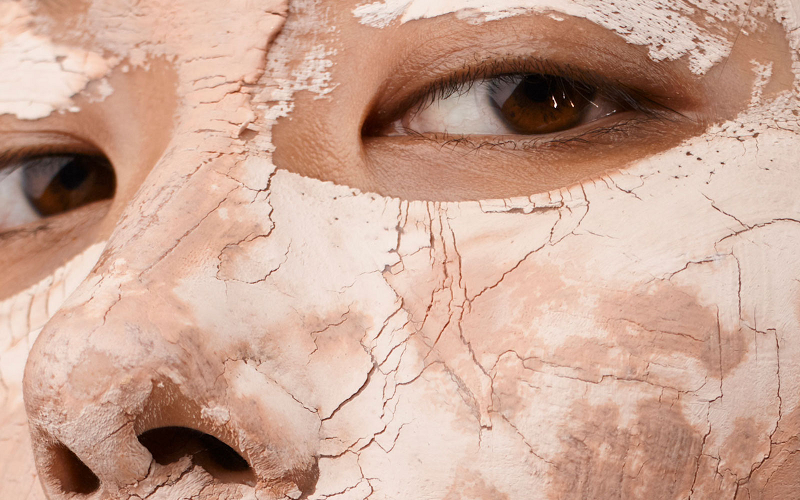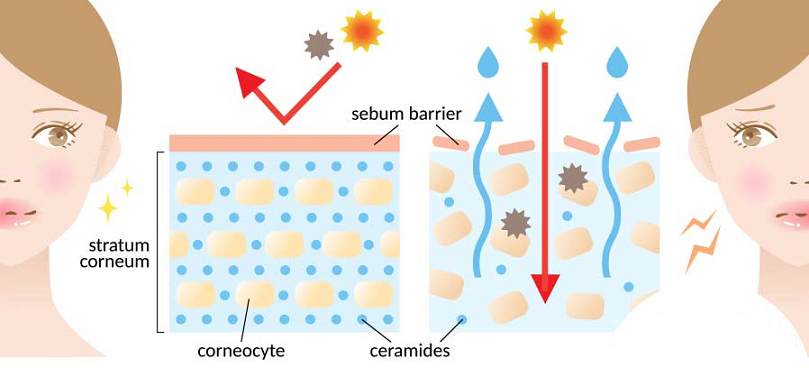
Ceramides, a type of lipid (fat) are an unsung hero in maintaining your skin’s vitality and youthfulness. This invisible warrior is a crucial component of your skin that battles dryness and promotes hydration. Despite their importance, ceramides often go unnoticed and misunderstood, leading many to overlook their significance in skin care routines.
Contents
Introduction to Ceramides and Skin Health
Before we delve into the world of ceramides, let’s take a moment to understand the importance of skin health. Our skin is the largest organ of our body and serves as the first line of defense against external threats. It protects us from harmful bacteria, regulates our body temperature, and even plays a role in our sensory perception.
When our skin is healthy, it can effectively perform these functions. However, when it’s dry or damaged, it can lead to discomfort, premature aging, and increased susceptibility to infections. That’s where ceramides come into play.
Ceramides are a type of lipid (fat) that naturally occur in the uppermost layers of our skin. They play a vital role in maintaining the skin’s barrier and retaining moisture. In fact, ceramides make up over 50% of our skin’s composition. Despite their prevalence and importance, they’re often overlooked in discussions about skin health.
Understanding Skin Structure
To fully appreciate the role of ceramides in maintaining skin health, it’s essential to first understand the basic structure of our skin. Our skin is a complex organ, composed of multiple layers, each with its own unique function and composition.
Explanation of the Skin’s Layers
Our skin is primarily made up of three layers: the epidermis, the dermis, and the hypodermis. The outermost layer, the epidermis, is what we see and touch every day. It’s responsible for protecting our bodies from external threats and is where ceramides primarily reside. Beneath the epidermis is the dermis, which contains blood vessels, nerve endings, and the roots of our hair and sweat glands. The deepest layer, the hypodermis, is mostly composed of fat and connective tissue, providing insulation and cushioning for our bodies.
Role of Lipids in Skin Health
Within the epidermis, there are several types of lipids, including ceramides, cholesterol, and free fatty acids. These lipids are crucial for maintaining the skin’s barrier function and preventing water loss. They form a protective layer on the skin’s surface, locking in moisture and keeping out harmful substances. When the balance of these lipids is disrupted, it can lead to dry, irritated skin [1].
Introduction to the Skin Barrier
The skin barrier, also known as the stratum corneum, is the outermost part of the epidermis. It’s composed of dead skin cells, or corneocytes, and the lipids that surround them. This barrier is our skin’s first line of defense against environmental stressors like pollution, UV radiation, and bacteria. It also plays a crucial role in maintaining skin hydration by preventing water loss. Ceramides, as part of this lipid matrix, are instrumental in maintaining the integrity and function of the skin barrier.

The Role of Ceramides in Skin Health
Now that we have a basic understanding of skin structure and the importance of lipids in maintaining the skin barrier, let’s delve deeper into the role of ceramides. These tiny molecules, though often overlooked, play a pivotal role in maintaining skin health and hydration.
Definition and Function of Ceramides
Ceramides are a type of lipid that naturally occur in the uppermost layers of our skin. They are waxy lipid molecules, composed of sphingosine and a fatty acid, that are crucial for maintaining the skin’s barrier and retaining moisture. Ceramides essentially act like a glue, holding skin cells together and forming a protective layer that plumps the skin and retains moisture.
How Ceramides Contribute to the Skin Barrier
Ceramides are a key component of the skin barrier. They are part of the lipid matrix that surrounds the corneocytes in the stratum corneum. This lipid matrix, which also includes cholesterol and free fatty acids, forms a waterproof barrier that seals in moisture and prevents the entry of harmful substances. By maintaining the integrity of this barrier, ceramides help to keep our skin hydrated and protected [2].
The Impact of Ceramides on Skin Hydration
Ceramides play a significant role in skin hydration. They help to lock in moisture, preventing dryness and irritation. When the skin is lacking in ceramides, it can lead to a compromised skin barrier, resulting in increased water loss and dry, flaky skin. Therefore, maintaining adequate levels of ceramides is crucial for keeping our skin hydrated and healthy.

The Invisible Warrior: Ceramides and Dry Skin
Having established the importance of ceramides in maintaining skin health and hydration, let’s now turn our attention to their role in combating dry skin. Dry skin is a common issue that can result from various factors, including environmental conditions, aging, and a compromised skin barrier.
The Connection Between Ceramides and Dry Skin
Dry skin often results from a compromised skin barrier that allows moisture to escape, leading to dehydration of the skin cells. As we’ve learned, ceramides are a key component of the skin barrier, helping to seal in moisture and prevent water loss. When ceramide levels are low, the skin barrier can become compromised, leading to increased water loss and resulting in dry, flaky skin. Therefore, maintaining adequate ceramide levels is crucial for preventing dry skin.
How Ceramides Combat Dryness
Ceramides combat dryness by reinforcing the skin barrier and locking in moisture. They fill the spaces between skin cells, acting like a sealant that prevents water loss. By doing so, they help to keep the skin hydrated and plump, reducing dryness and flakiness. Moreover, by strengthening the skin barrier, ceramides also help to protect the skin from environmental stressors that can cause dryness and irritation [3].
The Consequences of Ceramide Deficiency
A deficiency in ceramides can have serious consequences for skin health. Without enough ceramides, the skin barrier can become compromised, leading to increased water loss and dryness. Over time, this can lead to more serious skin issues, such as eczema and psoriasis, which are characterized by a compromised skin barrier. Furthermore, a lack of ceramides can also lead to premature aging, as dry, dehydrated skin is more prone to wrinkles and fine lines. Therefore, maintaining adequate ceramide levels is not just important for preventing dry skin, but also for maintaining overall skin health and youthfulness.

The Science Behind Ceramides and Skin Hydration
The role of ceramides in maintaining skin hydration isn’t just anecdotal; it’s backed by a wealth of scientific research.
Overview of Scientific Studies on Ceramides
Numerous scientific studies have highlighted the importance of ceramides in maintaining skin health. For instance, a study published in the Journal of Investigative Dermatology found that individuals with dry skin often have lower levels of ceramides in their skin. Another study in the Journal of Lipid Research found that ceramides play a crucial role in maintaining the skin barrier and that a deficiency in ceramides can lead to skin disorders like atopic dermatitis [4].
The Effectiveness of Ceramides in Skin Care Products
Research has also shown that topical application of ceramides can be beneficial for skin health. A study in the Journal of Clinical and Aesthetic Dermatology found that using a moisturizer containing ceramides improved skin hydration and helped to repair the skin barrier in individuals with dry skin. Another study in the Journal of the American Academy of Dermatology found that ceramide-containing skin care products were effective in treating eczema, a condition characterized by a compromised skin barrier.
The Long-Term Benefits of Ceramides for Skin Health
The benefits of ceramides for skin health aren’t just short-term; they can also have long-term effects. Regular use of ceramide-containing skin care products can help to continuously replenish the skin’s ceramide levels, maintaining the integrity of the skin barrier and preventing dryness. Over time, this can lead to healthier, more hydrated skin. Furthermore, by maintaining a strong skin barrier, ceramides can also help to protect the skin from environmental stressors, reducing the risk of skin issues like premature aging and skin disorders [5].
How to Boost Ceramide Levels in Your Skin
Understanding the importance of ceramides in maintaining skin health and hydration naturally leads to the question: how can we boost ceramide levels in our skin? Fortunately, there are several ways to increase your skin’s ceramide content, from dietary changes to topical products and lifestyle modifications.
Dietary Changes to Increase Ceramide Production
Certain foods are rich in sphingolipids, which are used by our bodies to produce ceramides. These include dairy products, eggs, soybeans, wheat germ, and whole grains. Incorporating these foods into your diet can help to naturally boost your skin’s ceramide levels. Additionally, staying well-hydrated can also support skin health and hydration.
Topical Products Containing Ceramides
One of the most effective ways to increase ceramide levels in the skin is through the use of topical products that contain ceramides. These products, which include moisturizers, serums, and cleansers, can help to replenish the skin’s ceramide content, strengthening the skin barrier and locking in moisture. When choosing a ceramide-containing product, look for one that also contains other skin-friendly ingredients like cholesterol and free fatty acids, as these work together with ceramides to maintain the skin barrier.
Lifestyle Changes to Support Skin Health
Lifestyle factors can also impact ceramide levels in the skin. For instance, excessive sun exposure can deplete the skin’s ceramide content, leading to a compromised skin barrier and dryness. Therefore, protecting your skin from the sun by wearing sunscreen and protective clothing can help to preserve your skin’s ceramide levels. Additionally, avoiding harsh soaps and cleansers that can strip the skin of its natural oils can also help to maintain the skin’s ceramide content and prevent dryness.
References
[1] Ceramides for skin: Benefits, side effects, and more
[2] Skin hydration is significantly increased by a cream formulated to mimic the skin’s own natural moisturizing systems
[3] Dermatologists Explain Why Ceramides Are So Important for Your Skin’s Health
[4] How to Get Rid of Dry Skin This Winter, According to Dermatologists
[5] Dry Skin: Diagnosis and Treatment
